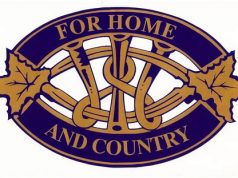The Ontario Federation of Agriculture (OFA) is celebrating its 80th anniversary this year. There were mergers and many challenges along the way so you could say it’s been a bit of a difficult intermix union, uh federation.
This general farm organization was established in 1936 as the Ontario Chamber of Agriculture. It was founded by the United Farmers of Ontario, the United Farmers’ Co-operative Company Ltd., and various growers and other agricultural organizations as a non-partisan lobbying and marketing organization for farmers. In 1939 the Ontario Chamber of Agriculture amended its constitution to admit county chapters of agriculture as members. In 1940 The Women’s Institute of Ontario and the United Farm Women of Ontario become members. The name was then changed to the Ontario Federation of Agriculture. In 1943, the UFO dissolved and its remnants were absorbed by the OFA.
The OFA comprises 52 county farm organizations from across the province. Many of these county federations have recently or are now celebrating their 75th anniversary.
Renfrew County Federation of Agriculture is celebrating its 75th anniversary this year. I have been reading through the first Minute Book that begins in 1941 and goes to1960 to read about the early history of the local federation. There are over 300 large pages filled with handwritten minutes. It’s a good thing I’m a history buff as it’s slow reading – much of the handwriting is hard to decipher.
On October 10, 1941 a group of positive-minded farmers got together in the office of the Department of Agriculture in Renfrew to establish the Renfrew County chapter of the Ontario Federation of Agriculture. The elected board consisted of 10 men and a woman as secretary. The board represented most farming areas of the county, including the hilly area of Brudenall.
Until 1970 the OFA was a true federation. Membership consisted of almost all commodity associations and a number of co-operatives including the United Co-operatives of Ontario (UCO). In addition, the county and township federations were indirectly represented on the board of the OFA through five zone federations. There was no direct farm membership. As a means of establishing closer communications with individual farmers the OFA sponsored the Farm Forum which encouraged small group discussions of the National Farm Radio broadcasts.
The Radio Forum is mentioned many times in the federation’s Minute Book. The Canadian National Farm Radio Forum was launched in January 1941 as an innovative partnership among three newly-formed organizations: the Canadian Association for Adult Education (CAAE), the Canadian Broadcasting Corporation (CBC), and the Canadian Federation of Agriculture (CFA). During the winter months from 1941 to 1965, the Farm Radio Forum supplemented weekly radio broadcasts for the casual listener with printed educational materials that were mailed in advance to registered rural discussion forums. Views of the various forums were fed back to OFA head office for use in the federation’s policies and programs. At its peak in 1949, it consisted of over 1,600 registered Forums, with over 21,000 registered individuals listening to a single broadcast nationwide. The Farm Radio Forum ended in Canada in 1965.
In 1964 an Amalgamation Committee was formed to consider the merging of the OFA and the National Farmers Union in Ontario. I’m sure some of our older farmers can recall the GFO plebiscite of 1969 – for a single general farm organization.
Close to 20,000 farmers came together on May 24, 1967 and marched on Parliament Hill which led to a groundswell of concern for creation of a single farm organization at the 1967 OFA convention.
At the 1968 OFA convention, a committee report recommends that the agriculture minister “conduct a producer vote by February, 1969, requiring a 51 percent majority of those voting to favour establishment of The One Farm Organization and a compulsory producer check-off on all farm products, produced and sold in Ontario to finance The One Farm Organization.”
The provincial government passed Bill 140, An Act to Provide for the Establishment, upon an Opinion Poll by Secret Ballot of the Farmers in Ontario, of a General Farm Organization, which specified that at least 60 percent of the farmers voting had to be in favour in order for the establishment of a General Farm Organization to take place as specified. It wasn’t long after the submission of the six-man report that the opposing forces began to organize, focusing on whether separate commodity organizations would exist within the GFO or whether their functions would be transferred to a commodity department of the new organization. General consensus seemed to be that this matter should be dealt with in the voting in order to get a producer opinion.
By voting day, there was a major move opposing the GFO, including agribusiness interests taking out advertisements, and the posting of NO posters on voting day.
Voting day people stayed away in droves and the majority of those who voted were against the establishment of the proposed General Farm Organization. Of the 91,653 ballots cast, 43.3 percent voting “yes” and 55.2 percent voting “no”.
Now 45 years later it’s still hard to believe that half of the farmers did not turn out to vote. No surprise that the proposed GFO was voted down.







![Kenopic/Smith Auction [Paid Ad]](https://whitewaternews.ca/wp-content/uploads/2018/10/advertising-100x75.jpeg)

